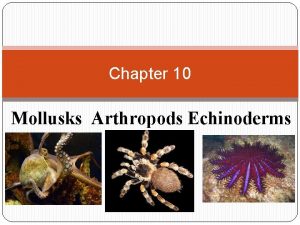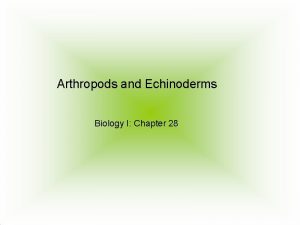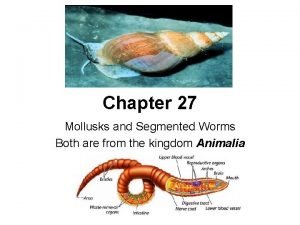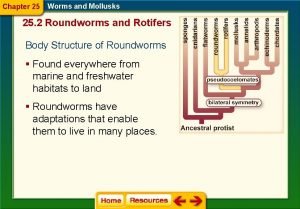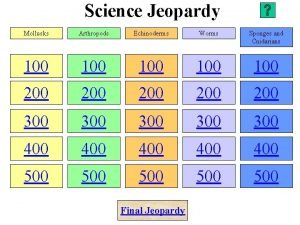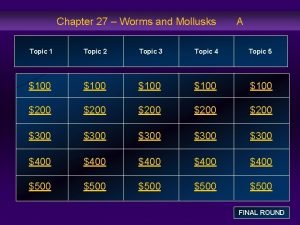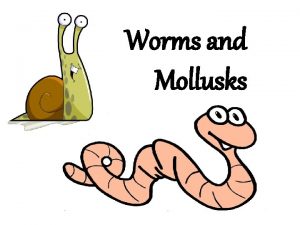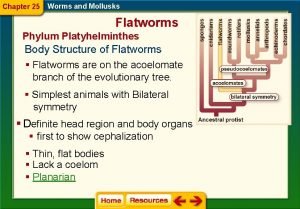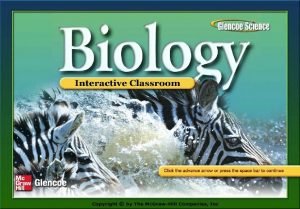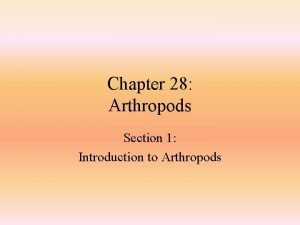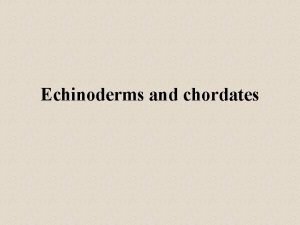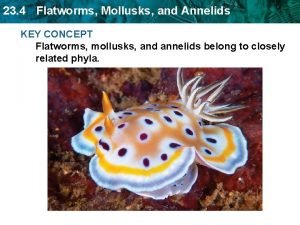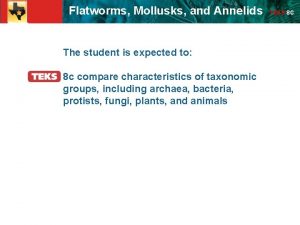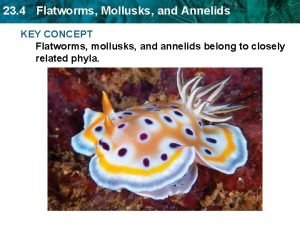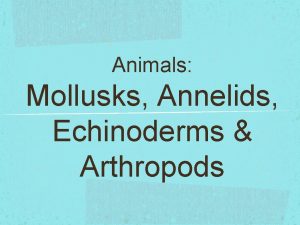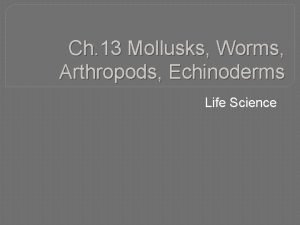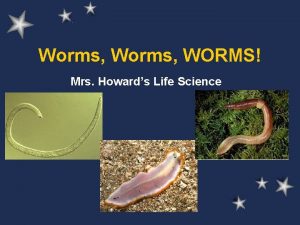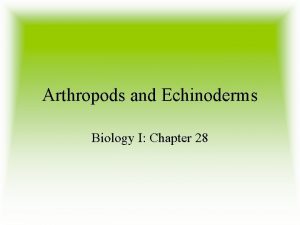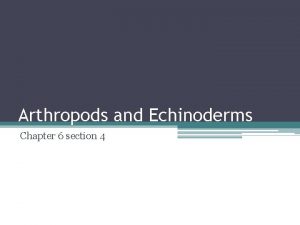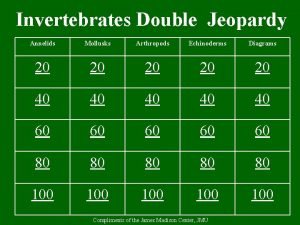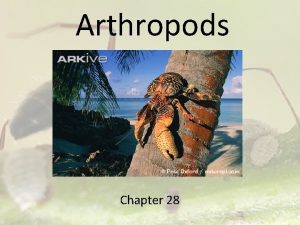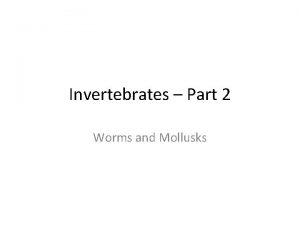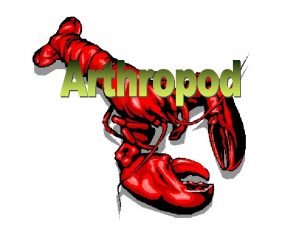Chapter 13 Notes Mollusks Worms Arthropods and Echinoderms














- Slides: 14

Chapter 13 Notes Mollusks, Worms, Arthropods, and Echinoderms

Mollusks - Mollusks are soft-bodied invertebrates with bilateral symmetry and usually one or two shells. (snails, clams, and squid) - Mantle- thin layer of tissue that covers the body organs. - Gills- the organs in which carbon dioxide is exchanged for oxygen in the water. - Open Circulatory System- the heart moves blood out into the open spaces around the body organs; there are no tubes for the blood like veins and arteries.

Classification of Mollusks - The first thing scientist look at when they classify mollusks is whether or not the animal has a shell. - Mollusks that have shells are then classified by the kind of shell and kind of foot that they have. - Gastropods are the largest group of mollusk. - They have a single shell, except for slugs, and use a radula to obtain food. - Radula- tongue-like organ with rows of teeth used to scrape and tear food materials. - Univalve- they have a single shell.

Classification of Mollusk - Bilvalves are mollusks that have a hinged, two-part shell joined by strong muscles ( clams, oysters, and scallops). - Cephalopods are the specialized and complex mollusk. - Squid, octopus, cuttlefish, and the chambered nautiluses belong to this group. - Cephalopods have large, well developed heads and it means “headfooted” - Unlike most mollusk cephalopods have a closed circulatory system. - Closed circulatory system- blood containing food and oxygen moves through the body in a series of closed vessels.

Cephalopods Octopus Squid Cuttlefish Chambered Nautiluses

Section 2 Segmented Worms - The worms you see crawling across sidewalks after a rain and those used for fishing are called annelids. - Annelid means “Little Rings”. - Setae- bristle-like structures on the outside of each body segment used to hold on to the soil and to move. - Earthworms are the most well known annelids. - Crop- sac in earthworms used for food storage. - Gizzard- muscular structure in earthworms that grinds the soil and bits of organic matter.

Leeches - Leeches are segmented worms but their bodies are not as round or long as earthworms are, and they don’t have a setae. - They feed on the blood of other animals. - Sometimes leeches are used after surgery to keep blood flowing to the repaired area. - Leeches produce many chemicals, including an anesthetic that numbs the wound so you don’t feel its bite.

Section 3 Characteristics of Arthropods - Arthropod means “jointed foot”. - Appendages- jointed structures including legs, antennae, claws, and pinchers used for movement, capturing prey, feeding, mating and sensing the environment. - Arthropods have bilateral symmetry, segmented bodies, an exoskeleton, a body cavity, a digestive system and a nervous system. - Exoskeleton- hard, outer covering that supports and protects the internal body. - Molting- the exoskeleton is shed and replaced by a new one so the animal can grow.

Insects - More species of insects exist than all other animal groups combined. - More than 700, 000 species of insect has been classified and scientist are identifying more and more each year. - Insects have 3 pairs of legs. - Insects have an open circulatory system that carries digested food to cells and removes waste. - However, insect blood does not carry oxygen because it does not have hemoglobin. - Instead insects have openings called spiracles.


Insects - Spiracles- openings on the abdomen and thorax of insects where air and waste gases are exchanged. - Metamorphosis- changes in body form that many insects go through as they grow.

Arachnids - Arachnids- arthropods with two body regions ( cephalothorax and abdomen) and 8 legs. - Arachnids include spiders, scorpions, mites, and ticks. Scorpion Spider Mite Tick

Centipedes and Millipedes - Centipedes have 1 pair of legs per segment and millipedes have 2 pair per segment. - Insecticides are used to control the population of insects. Centipede Millipede

Section 4 Echinoderms - Water-vascular system- network of water-filled canals with thousands of tube feet that allows them to move, exchange carbon dioxide and oxygen, capture food, and release waste. - Tube Feet- hollow, thin-walled tubes with a suction cup at the end that helps the echinoderm move. - The largest group of echinoderms is sea stars.
 Echinoderms
Echinoderms Chapter 28 arthropods and echinoderms
Chapter 28 arthropods and echinoderms Chapter 27 mollusks and segmented worms
Chapter 27 mollusks and segmented worms Chapter 25 section 4 segmented worms
Chapter 25 section 4 segmented worms Chapter 27 mollusks and segmented worms answer key
Chapter 27 mollusks and segmented worms answer key Chapter 27 mollusks and segmented worms
Chapter 27 mollusks and segmented worms Chapter 27 worms and mollusks
Chapter 27 worms and mollusks Characteristics of worm
Characteristics of worm Are worms mollusks
Are worms mollusks Chapter 25 section 3 mollusks
Chapter 25 section 3 mollusks Chapter 28: arthropods worksheet answers
Chapter 28: arthropods worksheet answers Echinoderms and chordates
Echinoderms and chordates Section 4 flatworms mollusks and annelids
Section 4 flatworms mollusks and annelids Section 4 flatworms mollusks and annelids
Section 4 flatworms mollusks and annelids Section 4 flatworms mollusks and annelids
Section 4 flatworms mollusks and annelids
